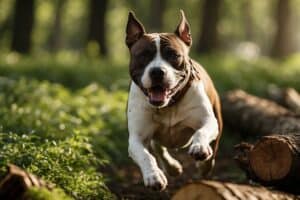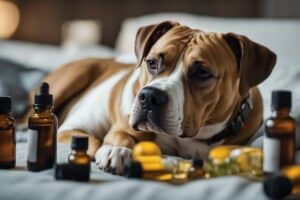Maintaining the eye health of dogs is a vital aspect of their overall care that can significantly impact their quality of life.
Dog owners have the responsibility of ensuring their furry friends can see the world as clearly as possible.
Integrating simple eye care practices into their routine at home can prevent common ocular issues and contribute to their pet’s comfort and happiness.
By being attentive to their dog’s eye health, owners can catch signs of potential problems early and can take steps to address them before they become serious.

Home eye care for dogs involves regular monitoring and gentle cleaning that can protect them from irritants and infections.
Since dogs are curious by nature, they can often expose their eyes to dirt and debris, which necessitates routine cleaning.
Dog owners need to be familiar with the proper techniques for cleaning around the eyes and the signs that may indicate a trip to the vet is necessary.
Using vet-approved products for eye care and ensuring their dog is on a diet that supports eye health are proactive ways to maintain their pet’s vision.
Understanding Common Eye Problems in Dogs

It’s essential to recognize the potential signs of eye problems in dogs and understand how age-related changes can impact their vision.
Knowing the common eye conditions like cataracts and glaucoma will enable proactive care for a dog’s eyesight.
Recognizing Signs of Eye Problems
Dog owners should be alert for symptoms indicating eye issues. These signs may include:
- Excessive tearing or discharge
- Redness in the whites of the eyes
- Cloudiness or changes in eye color
- Squinting or frequent blinking
- Rubbing or pawing at the eyes
These symptoms can suggest a range of conditions from mild conjunctivitis to more serious diseases like glaucoma.
The Impact of Age-Related Changes
As dogs age, they are more susceptible to age-related eye changes such as:
- Development of cataracts, seen as cloudiness in the eye lens
- Onset of dry eyes, where tear production decreases
- Increased risk of Progressive Retinal Atrophy (PRA), a degenerative eye disease
These changes can diminish a dog’s quality of life if not managed with proper care.
Common Conditions: From Dry Eyes to Cataracts
Several conditions are commonly diagnosed in canines, including:
- Dry Eyes (Keratoconjunctivitis Sicca): Lack of adequate tear production leading to irritation
- Conjunctivitis: Inflammation of the conjunctiva, often presenting with redness and discharge
- Corneal Ulcers: Painful open sores on the cornea that can be caused by trauma or infection
- Cherry Eye: A prolapse of the third eyelid’s tear gland, noticeable as a red mass in the corner of the eye
- Cataracts: Opacity in the eye’s lens, which can lead to blindness if left untreated
- Glaucoma: Increased pressure within the eye, potentially damaging the optic nerve and leading to vision loss
Early detection and appropriate treatment are crucial for these conditions.
For instance, a guide to eye health in dogs stresses the importance of consulting specialists for certain eye diseases that general practice veterinarians may not be equipped to manage.
Daily Eye Care Routine for Your Dog

Maintaining your dog’s eye health is a crucial part of their overall well-being.
A daily routine that includes proper cleaning techniques and regular exams can help keep your dog’s eyes clear and infection-free.
Proper Cleaning Techniques
When it comes to eye hygiene, gentle handling is key.
Always use a clean, damp cloth to wipe away any crust or discharge around the eyes, taking care not to press on the eye itself.
For breeds with longer fur, grooming around the eyes is essential to prevent irritation.
Products like specially formulated eye wipes for dogs can be used to safely keep the area clean and free from debris.
If your dog has been exposed to irritants or is particularly sensitive, a sterile eyewash can help flush out any contaminants.
Regular Eye Exams at Home
Regular eye exams at home can help you spot any potential issues early.
Inspect your dog’s eyes daily for signs like cloudiness, change in eye color, redness, or a persisting squint—all of which could indicate a need for a veterinary visit.
Proper lighting is essential for accurate home exams, so perform them in a well-lit area. A healthy dog eye should be clear and bright.
Any abnormalities in the appearance or behavior of your dog’s eyes should prompt a visit to the vet for a professional diagnosis and treatment.
Diet and Nutrition for Healthy Canine Eyes

A well-balanced diet enriched with certain nutrients can contribute significantly to the health of your dog’s eyes.
Key antioxidants are crucial for preventing oxidative damage, while specific vitamins support optimal vision.
Essential Antioxidants for Eye Health
Antioxidants are vital in combating oxidative stress, a factor that can contribute to age-related eye conditions in dogs.
Here are some essential antioxidants for maintaining eye health:
- Zeaxanthin and Lutein: Found in leafy greens such as kale and spinach, these antioxidants support the health of the retina.
- Beta-Carotene: This precursor to vitamin A, present in carrots and sweet potatoes, is essential for night vision and overall eye condition.
- Astaxanthin: Though less common, astaxanthin is a powerful antioxidant from certain algae and can be found in high-quality dog food or supplements.
Feeding your dog a diet rich in these antioxidants can help maintain their eye health over time.
Consider incorporating antioxidant-rich foods to support their vision.
Feeding for Optimal Vision and Eye Condition
Nutrition plays a pivotal role in maintaining your dog’s eye health. Ensure their diet includes:
- Omega-3 Fatty Acids: These are critical for cell membrane health in the eyes.
Flaxseed and fish oil are great sources.
- Vitamins C and E: Vital for reducing oxidative damage, they can be found in many dog foods formulated for eye health.
- Meats and Eggs: These foods provide amino acids and nutrients vital for maintaining eye structure and function.
A diet tailored for eye health, along with regular veterinary checkups, will promote clear vision and prevent common eye issues.
Consider consulting with a vet for personalized advice on feeding your dog for optimal eye condition.
Handling Eye Emergencies and When to See a Vet

When a dog suffers an eye injury, quick and appropriate action is crucial.
Understanding how to provide first aid and recognizing when to seek professional care can make a significant difference in a pet’s recovery.
First Aid for Eye Injuries
Immediate Action: If a dog incurs an eye injury, gentle first aid can be administered.
The focus should be on preventing further damage and preparing for a swift trip to the vet if necessary.
For damaged tissue or tears, apply a cold compress to the affected area without exerting pressure for 5-10 minutes; this can help reduce swelling and discomfort.
In cases of excessive rubbing or pawing at the eye, an Elizabethan collar (e-collar) is recommended to protect the eye from additional trauma.
Identifying Symptoms that Require Professional Care
Critical Observations:
- Foreign Bodies: If you notice your dog squinting or excessively tearing and suspect a foreign body, do not attempt to remove it.
This is a task for a professional to avoid additional injury.
- Swelling and Redness: Persistent swelling, redness or any significant change in the eye’s appearance should prompt an immediate veterinary visit.
These can be signs of severe irritation or the onset of an infection.
- Unusual Discharge: Any green or yellow discharge, or a change in the eyes that leads to excessive blinking or discharge, is cause for concern and warrants a consultation with a veterinarian.
Many eye emergencies in dogs, such as glaucoma or inflammation, require the attention of a veterinary ophthalmologist due to their complexity.
Veterinary care should be sought without delay when a pet exhibits signs of acute vision loss or distress related to their eyes.
Preventive Measures to Protect Your Dog’s Eyes

Maintaining your dog’s eye health begins with preventive care.
Taking simple measures can shield them from various eye conditions and support their well-being. Here are key precautions to take:
- Regular Inspections: Examine your dog’s eyes frequently for any signs of redness, cloudiness, or discharge.
- Cleanliness: Use a moist cloth or specific pet eye wipes to gently clean around the eye area, removing dust and debris.
| Activity | Precaution |
|---|---|
| Bathing | Apply protective ophthalmic ointment to prevent soap from entering. |
| Playing | Monitor rough play which could lead to scratches or trauma to the eyes. |
| Outdoor Excursions | Consider dog goggles in harsh environments to defend against windblown debris or strong sunlight. |
- Trimming Fur: Keep fur around the eyes trimmed to avoid irritation and blockages of vision.
- Balanced Diet: A nutrient-rich diet bolsters overall health, including eye health.
- Veterinary Visits: Regular check-ups at the vet are critical; they can preempt the onset of more serious conditions.
If one notices symptoms or changes in their dog’s eyes, it’s crucial to consult with a veterinarian without delay.
Prevention is the ideal way to ensure that a pet’s eyes remain clear and healthy, allowing them to navigate their world safely.















